The Sketchy Claims of the Case for a Mask Mandate

New coronavirus cases are spiking again as we head into the colder months. While this pattern likely reflects the long-anticipated seasonality of the disease, the lockdown-aligned American news media is currently peddling a different narrative.
Not enough Americans are doing their duty to defeat the virus by wearing masks, we’re constantly hectored. To this end, the Washington Post ran a flashy visual display purporting to show that high-mask use states are faring better than the rest (conveniently omitting mention that many of those same states were the hardest hit during the first wave last spring, albeit at a time when mask use was less common).
Anthony Fauci – yes, the same Anthony Fauci who publicly discouraged mask use last March and later acknowledged he was lying at the time for political reasons – is now claiming that only a national mask-wearing mandate will save us from the months ahead. Further stoking the flames, the doomsayer modelers of the University of Washington’s IHME team have even published an updated forecast warning of an additional 500,000 deaths unless we all mask up.
There’s a fundamental problem however with the media’s current mask frenzy: the American public has already adopted mask-wearing at an extraordinarily high rate. In fact, we hit almost 80% mask use back in July according to a survey tracker of behavioral changes in response to the pandemic. Furthermore, the United States has consistently hovered in the 80% mask compliance territory ever since.
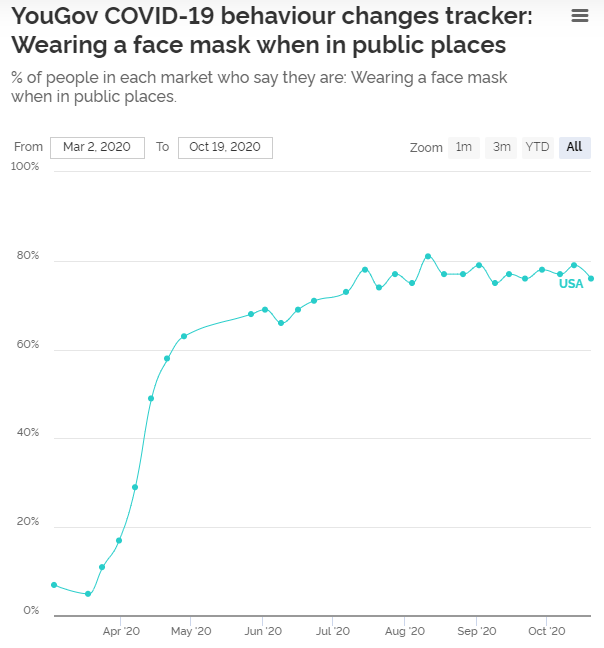
To give you a sense of perspective, the 80% mask use threshold is also where Thailand, Vietnam, and Taiwan have hovered since the beginning of the pandemic. These three Asian countries have thus far weathered the COVID-19 outbreak with only modest case counts – an outcome that is often attributed to their widespread adoption of masks after similar experiences in past regional epidemics such as SARS.
It took the US from March until mid-July to catch up with these countries – again, in part due to the misinformation given by Dr. Fauci and other public health officials early in the pandemic – but we’ve maintained near-parity with these supposed masking success stories for the last three months now.
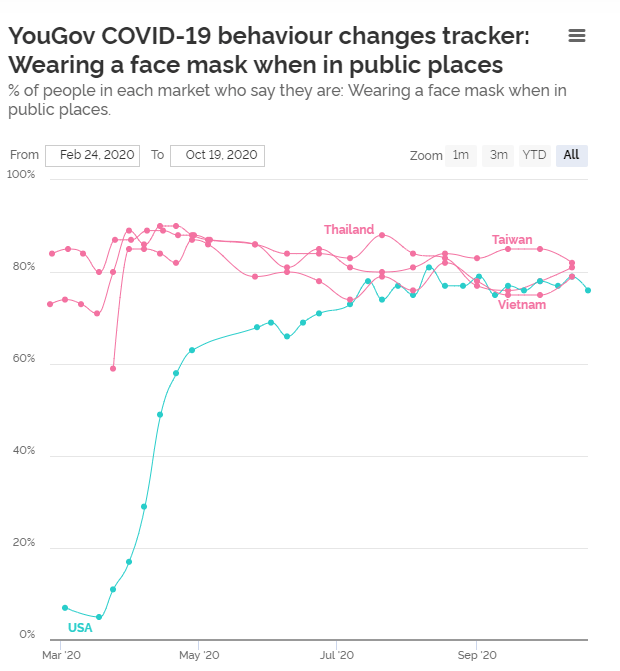
So how does masking in the United States stack up against other parts of the world? You would not believe it based on a prevailing media narrative that depicts “American individualism [as] an obstacle to wider mask wearing,” to quote a deeply misleading study by the Brookings Institution.
Yet again, the survey data belie the talking points. Since the start of the pandemic, United States’ mask adoption patterns have consistently outperformed such “socially responsible” nations as Germany, the United Kingdom, and the four Nordic countries.
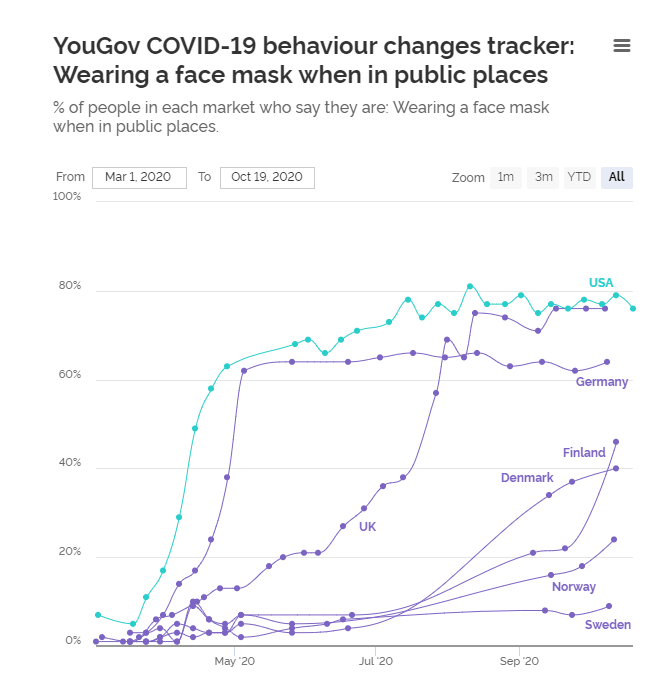
American mask usage rates also sit at parity with our northern neighbor Canada, and well exceed the lockdown-addicted dystopia of Australia.
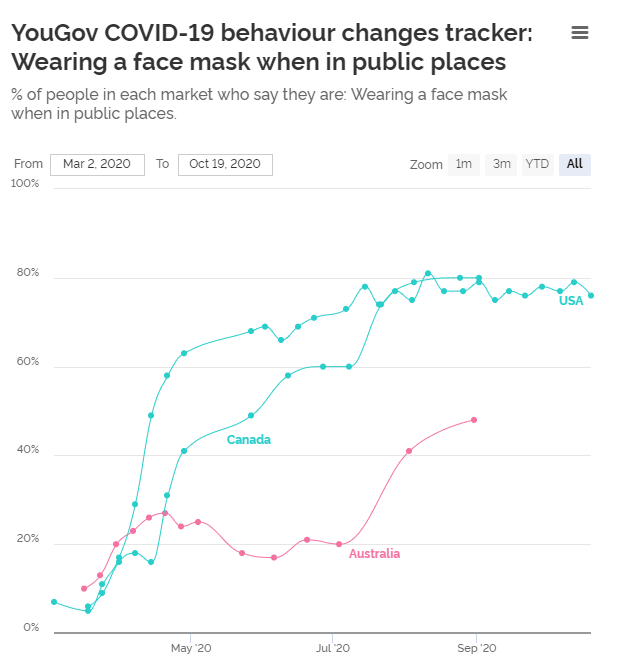
Mask use in some countries does exceed the United States pattern, but only slightly. Spain, Italy, and France have all hovered around 85 to 90% mask adoption since the late spring.
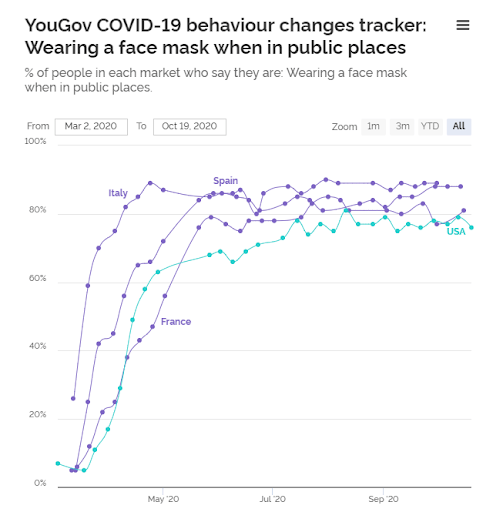
But there’s a hitch. Europe is currently undergoing a fall surge and, as of mid-October, has far overtaken the United States in daily new cases. As of this writing the surge appears to be indiscriminate, playing out in both the heavy mask regions of southern Europe and in countries that have lagged in mask adoption such as Germany and the United Kingdom. Widespread mask usage in France, Italy, and Spain clearly did not stop the European second wave, but neither did the European countries that lagged behind on mask adoption.
What then are we to make of these data on masking patterns? Keep in mind that the most recent epidemiological forecasting, such as the IHME model, places heavy weight upon the effectiveness of masks as a primary tool for COVID mitigation.
As an interesting aside, the IHME group recently published a new paper in the top science journal Nature where they claim that “the national [US] average for self-reported mask wearing was 49% as of 21 September 2020.” The citation for this figure however goes to the IHME’s own website, where they list a much higher 68% mask compliance rate for September 21st. By all appearances, the IHME paper’s conclusion is based on a simple typographical error that led them to severely understate the level of mask use in the United States.
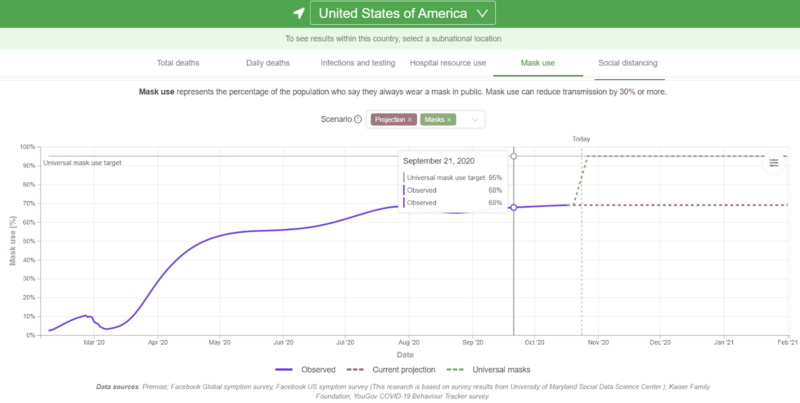
The typo is no small matter to their thesis. Citing the erroneous 49% figure, its authors assert that there is “a considerable population health benefit to mask use with great potential for uptake in the United States” and predict that almost a hundred thousand lives could be saved by increasing this number to their target level of 85%.
It now appears that they undershot their own mask compliance data by almost 20 percentage points, which in turn is another 10 percentage points below the latest survey data for the United States.
Curiously, the heavy focus on masks as a catch-all “solution” to COVID-19 was not the case only 8 months ago. The now-infamous lockdown forecast from Neil Ferguson of Imperial College even intentionally omitted masks from its equations. As Ferguson explained in his 2006 paper describing the model he then adapted to COVID-19, “We do not present projections of the likely impact of personal protective measures (for example, face masks) on transmission, again due to a lack of data on effectiveness.”
Some time in the intervening months however, masks became a magic bullet in both the media narrative and the epidemiology literature – and along with it a mythical perception that mask use remains uncommon.
As we see in the survey data above though, mask adoption is now widespread. It simply isn’t the silver bullet we were promised. Masks do appear to offer some benefit in reducing transmission under specific circumstances. For example, a comprehensive focused protection strategy would likely advise mask use in the presence of vulnerable populations and in certain indoor public settings, or even subsidize the provision of N-95 masks to senior citizens and other high-risk persons.
But the American population has already widely adopted masks to the tune of 80% usage for the last three months, with no signs of dissipating. Insofar as these practices help, they are likely to reduce exposure in the presence of vulnerable persons in certain settings. That much should be acknowledged and encouraged as part of a new focused protection strategy.
Yet as we are now seeing in Europe and parts of the United States though, the fall 2020 case surge came many months after the widespread adoption of masks in these regions. Masks are not the next big policy step to take, but rather one that most of the afflicted regions have already taken. They simply weren’t the universal panacea that our media and parts of the epidemiology profession promised.












